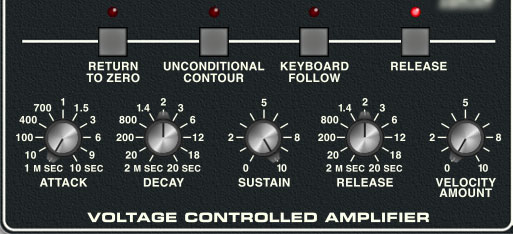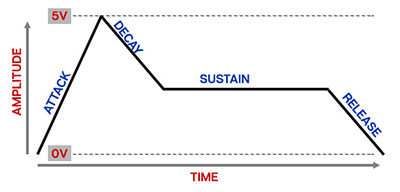
"Voltage controlled amplifier," is a chichi way of saying, "volume knob, controlled by voltage." A simple analogy would be to think of the voltage controlled amplifier (VCA) as a faucet that gets adjusted by an incoming control voltage from an envelope generator, low-frequency oscillator, or other modulation source.
Memorymode's VCA section doesn't have any dedicated controls per se, but it has a dedicated envelope generator for shaping amplitude curves.
VCA Envelope Generator
In case you didn't catch this in the filter section, here's an overview of how an ADSR envelope generator works:

When Memorymode sees a gate voltage from a note, the envelope generator outputs a dynamically changing voltage, according to the settings of its four stages. The attack stage defines how long it takes for the output voltage to rise from 0 to 5 volts. Once the attack stage reaches 5V, it moves to the decay phase, which defines how long it takes to fall from 5V to the setting of the Sustain phase. Unlike the attack, decay, and release phases, which define times, sustain simply sets the held voltage level following the attack and decay phases - this equates to the envelope output level while holding down a key. Finally, the release slider defines the the length of time it takes for the voltage to fall back to 0V when the gate input voltage is removed, i.e. when the key is released.

Attack- Defines the length of time for voltage to rise from 0V to 5V when a key is played.
Decay- Defines the length of time for voltage to fall from the attack stage 5V peak to sustain stage setting.
Sustain- Sets the voltage level following attack and decay phases while a note is held.
Release- Defines the length of time for voltage to fall from sustain level to 0V when a key is released.
Velocity Amount- Defines how much the envelope affects amplitude via keyboard velocity. When set to zero, keyboard velocity has no effect on amplitude; all the way up results in maximum control range.

Return To Zero- If a voice is retriggered during its attack phase, normally the new note will begin at the current attack voltage level. If the Return To Zero button is engaged, the attack voltage will reset to 0 volts.
Return To Zero was also a failed side project from Boston guitarist Barry Goudreau (along with the questionably named Orion The Hunter). That guy just couldn't catch a break.
Unconditional Contour- When disabled, the envelope generators will enter the release phase only when keys are released. When Unconditional Contour is enabled, notes will play through their attack phase and immediately jump to the release phase (whether notes are held or not). This effectively makes makes them attack/release or "AR" envelopes.
Keyboard Follow- When engaged, attack, decay, and release times get shorter as higher notes are played on the keyboard. The (possibly dubious) idea is to imitate the way acoustic instruments behave (because this thing is gonna sound JUST LIKE a real piano).
Release- Turning this off disables the envelope release stage (in case the concept of turning the Release knob all the way down is confusing for you). We don't know why synths used to have these, but a number of 70s and 80s analog synths did, so go figure.
Note that Return To Zero (which sounds like a new wave band), Unconditional Contour (which sounds like a hair product), Keyboard Follow, and the Release button all affect both the filter and VCA envelopes.